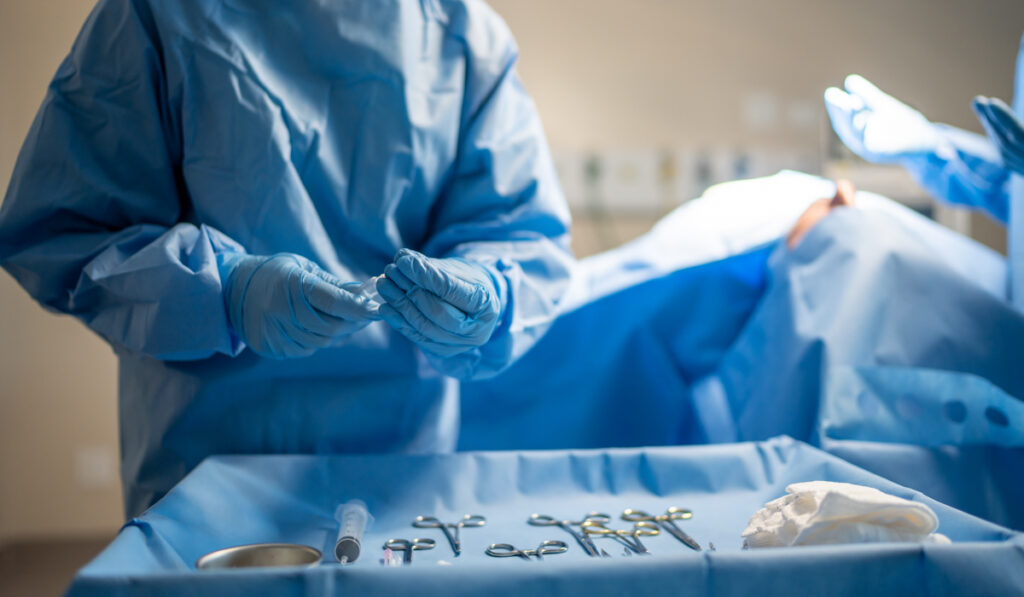Surgical-site infections (SSIs) are common after open abdominal surgery – to the extent that many surgeons provide wound irrigation with antiseptic solutions during surgery.
However, the field’s best practices for preventing and treating these post-surgical infections have not been determined.
In a recent randomized trial, a team of researchers examined the effectiveness of irrigation with polyhexanide 0.04 percent solution in preventing infection following laparotomy. Two infectious disease experts at Vanderbilt University Medical Center, Jeffrey S. Upperman, M.D., and Eunice Y. Huang, M.D., weighed in on the results of the trial, publishing a commentary in JAMA Surgery.
“This study caught our attention,” Huang said. “As surgeons, we are constantly searching for new adjuncts and alternative modalities to mitigate intraoperative infection risk.”
“As surgeons, we are constantly searching for new adjuncts and alternative modalities to mitigate intraoperative infection risk.”
Effects of Intraoperative Wound Irrigation
In previous findings, the RECIPE trial showed a potential benefit of polyhexanide use in reducing SSIs, reigniting interest in antiseptic irrigation.
However, the most recent trial did not find significant differences in SSI rates among laparotomy patients given intraoperative wound irrigation with polyhexanide, saline irrigation, or no irrigation.
Based on these results, the authors of the study concluded that intraoperative wound irrigation with polyhexanide solution should not be recommended as standard practice in open clean-contaminated surgical procedures. But that’s not the whole story.
“Despite the conflicting results, there are additional points to consider,” Huang said.
Insights From Negative Results
In their commentary, Upperman and Huang noted that the most recent trial employed wound-edge protector devices in more than 25 percent of procedures, which could have masked the efficacy of the polyhexanide solution. Additionally, patient selection and surgical management likely differed when compared to the RECIPE trial.
“Several studies have reported on the benefits of wound-edge protector devices,” Huang explained. “The effectiveness of wound protectors could have eclipsed the efficacy of the polyhexanide solution in the study.”
Given the potential for bias with use of wound-edge protector devices, Huang and Upperman explained that future studies should explicitly control for different adjuncts to discern the true efficacy of each intervention in reducing surgical-site infections.
Commenting on the overall results, Upperman added: “I was delighted to see the authors revisited a fundamental clinical question.”
According to Huang, patients undergoing surgery can generally be categorized into two risk groups for infection — low and high. She recommends that surgeons tailor infection prevention measures based on the patient’s level of risk.
“Patients who are low risk may benefit from a wound protector and antibiotics, while high-risk patients should receive additional interventions to reduce the likelihood of SSI,” Huang explained.
Developing Strategies to Prevent SSIs
In addition to their own research, Upperman and Huang are actively involved in multiple projects at Vanderbilt aimed at reducing the risk of surgical-site infections.
“Minimizing SSI is a complex endeavor that demands a specialized team and the utilization of checklists and bundles to ensure optimal patient care,” Huang said.
“Minimizing SSI is a complex endeavor that demands a specialized team and the utilization of checklists and bundles to ensure optimal patient care.”
Huang explains that appropriate antibiotic prophylaxis is a crucial component of surgical workup and evaluation.
Furthermore, Huang and her team are designing digital dashboards to ensure that the appropriate guidelines for timing, dosage and classification of antibiotics are followed with patients before surgery. These dashboards also include metrics like glucose and temperature monitoring to assess infection risk prior to surgery.
“We’ve made progress, but there is still a lot of work to do,” Huang explained. “Vanderbilt is at the forefront of infection prevention, and our efforts will support the broader medical community.”






